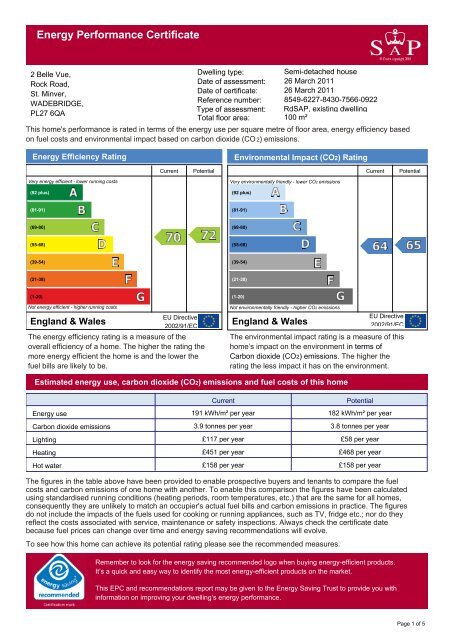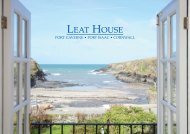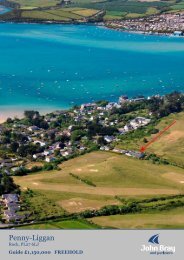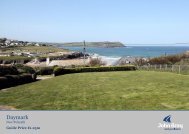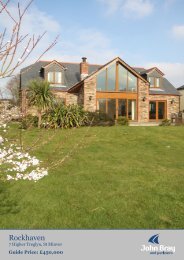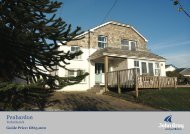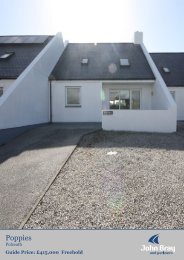EPC Report - John Bray & Partners
EPC Report - John Bray & Partners
EPC Report - John Bray & Partners
Create successful ePaper yourself
Turn your PDF publications into a flip-book with our unique Google optimized e-Paper software.
Energy Performance Certificate<br />
2 Belle Vue,<br />
Rock Road,<br />
St. Minver,<br />
WADEBRIDGE,<br />
PL27 6QA<br />
Dwelling type:<br />
Date of assessment:<br />
Date of certificate:<br />
Reference number:<br />
Type of assessment:<br />
Total floor area:<br />
Semi-detached house<br />
26 March 2011<br />
26 March 2011<br />
8549-6227-8430-7566-0922<br />
RdSAP, existing dwelling<br />
100 m²<br />
This home's performance is rated in terms of the energy use per square metre of floor area, energy efficiency based<br />
on fuel costs and environmental impact based on carbon dioxide (CO 2) emissions.<br />
Energy Efficiency Rating<br />
Environmental Impact (CO2) Rating<br />
Current Potential Current Potential<br />
Very energy efficient - lower running costs<br />
(92 plus)<br />
Very environmentally friendly - lower CO2 emissions<br />
(92 plus)<br />
(81-91)<br />
(81-91)<br />
(69-80)<br />
(69-80)<br />
(55-68)<br />
(55-68)<br />
(39-54)<br />
(39-54)<br />
(21-38)<br />
(21-38)<br />
(1-20)<br />
Not energy efficient - higher running costs<br />
England & Wales<br />
EU Directive<br />
2002/91/EC<br />
The energy efficiency rating is a measure of the<br />
overall efficiency of a home. The higher the rating the<br />
more energy efficient the home is and the lower the<br />
fuel bills are likely to be.<br />
(1-20)<br />
Not environmentally friendly - higher CO2 emissions<br />
England & Wales<br />
EU Directive<br />
2002/91/EC<br />
The environmental impact rating is a measure of this<br />
home’s impact on the environment in terms of<br />
Carbon dioxide (CO2) emissions. The higher the<br />
rating the less impact it has on the environment.<br />
Estimated energy use, carbon dioxide (CO2) emissions and fuel costs of this home<br />
Energy use<br />
Carbon dioxide emissions<br />
Lighting<br />
Heating<br />
Hot water<br />
Current<br />
Potential<br />
191 kWh/m² per year 182 kWh/m² per year<br />
3.9 tonnes per year 3.8 tonnes per year<br />
£117 per year<br />
£58 per year<br />
£451 per year<br />
£468 per year<br />
£158 per year<br />
£158 per year<br />
The figures in the table above have been provided to enable prospective buyers and tenants to compare the fuel<br />
costs and carbon emissions of one home with another. To enable this comparison the figures have been calculated<br />
using standardised running conditions (heating periods, room temperatures, etc.) that are the same for all homes,<br />
consequently they are unlikely to match an occupier's actual fuel bills and carbon emissions in practice. The figures<br />
do not include the impacts of the fuels used for cooking or running appliances, such as TV, fridge etc.; nor do they<br />
reflect the costs associated with service, maintenance or safety inspections. Always check the certificate date<br />
because fuel prices can change over time and energy saving recommendations will evolve.<br />
To see how this home can achieve its potential rating please see the recommended measures.<br />
Remember to look for the energy saving recommended logo when buying energy-efficient products.<br />
It’s a quick and easy way to identify the most energy-efficient products on the market.<br />
This <strong>EPC</strong> and recommendations report may be given to the Energy Saving Trust to provide you with<br />
information on improving your dwelling’s energy performance.<br />
Page 1 of 5
2 Belle Vue, Rock Road, St. Minver, WADEBRIDGE, PL27 6QA<br />
26 March 2011<br />
RRN: 8549-6227-8430-7566-0922<br />
Energy Performance Certificate<br />
About this document<br />
The Energy Performance Certificate for this dwelling was produced following an energy assessment undertaken by a<br />
qualified assessor, accredited by Elmhurst Energy Systems Ltd, to a scheme authorised by the Government. This<br />
certificate was produced using the RdSAP 2005 assessment methodology and has been produced under the Energy<br />
Performance of Buildings (Certificates and Inspections) (England and Wales) Regulations 2007 as amended. A copy<br />
of the certificate has been lodged on a national register.<br />
Assessor’s accreditation number:<br />
Assessor’s name:<br />
Company name/trading name:<br />
Address:<br />
Phone number:<br />
Fax number:<br />
E-mail address:<br />
Related party disclosure:<br />
EES/005411<br />
Mr. Andrew Daniell<br />
Cornish <strong>EPC</strong><br />
20 Rosevale Gardens, Luxulyan, Cornwall, PL30 5EP<br />
01726 852765<br />
01726 850154<br />
office@cornishepc.co.uk<br />
No related party<br />
If you have a complaint or wish to confirm that the certificate is genuine<br />
Details of the assessor and the relevant accreditation scheme are as above. You can get contact details of the<br />
accreditation scheme from their website at www.elmhurstenergy.co.uk together with details of their procedures for<br />
confirming authenticity of a certificate and for making a complaint.<br />
About the building’s performance ratings<br />
The ratings on the certificate provide a measure of the building's overall energy efficiency and its environmental<br />
impact, calculated in accordance with a national methodology that takes into account factors such as insulation,<br />
heating and hot water systems, ventilation and fuels used. The average Energy Efficiency Rating for a dwelling in<br />
England and Wales is band E (rating 46).<br />
Not all buildings are used in the same way, so energy ratings use 'standard occupancy' assumptions which may be<br />
different from the specific way you use your home. Different methods of calculation are used for homes and for other<br />
buildings. Details can be found at www.communities.gov.uk/epbd.<br />
Buildings that are more energy efficient use less energy, save money and help protect the environment. A building<br />
with a rating of 100 would cost almost nothing to heat and light and would cause almost no carbon emissions. The<br />
potential ratings on the certificate describe how close this building could get to 100 if all the cost effective<br />
recommended improvements were implemented.<br />
About the impact of buildings on the environment<br />
One of the biggest contributors to global warming is carbon dioxide. The way we use energy in buildings causes<br />
emissions of carbon. The energy we use for heating, lighting and power in homes produces over a quarter of the<br />
UK's carbon dioxide emissions and other buildings produce a further one-sixth.<br />
The average household causes about 6 tonnes of carbon dioxide every year. Adopting the recommendations in this<br />
report can reduce emissions and protect the environment. You could reduce emissions even more by switching to<br />
renewable energy sources. In addition there are many simple everyday measures that will save money, improve<br />
comfort and reduce the impact on the environment. Some examples are given at the end of this report.<br />
Click www.epcadviser.direct.gov.uk our online tool which uses information from this <strong>EPC</strong> to show<br />
you how to save money on your fuel bills.<br />
Further information about Energy Performance Certificates can be found under Frequently Asked<br />
Questions at www.epcregister.com<br />
Software Version: EES SAP 2005.018.03, January 2010, BRE SAP Worksheet 9.83<br />
Page 2 of 5
Recommended measures to improve this home’s energy performance<br />
2 Belle Vue,<br />
Rock Road,<br />
St. Minver,<br />
WADEBRIDGE, PL27 6QA<br />
Date of certificate: 26 March 2011<br />
Reference number: 8549-6227-8430-7566-0922<br />
Summary of this home’s energy performance related features<br />
The table below gives an assessment of the key individual elements that have an impact on this home’s energy<br />
and environmental performance. Each element is assessed by the national calculation methodology against the<br />
following scale: Very poor / Poor / Average / Good / Very good. The assessment does not take into<br />
consideration the physical condition of any element. ‘Assumed’ means that the insulation could not be<br />
inspected and an assumption has been made in the methodology based on age and type of construction.<br />
Elements<br />
Walls<br />
Roof<br />
Description<br />
Cavity wall, as built, insulated (assumed)<br />
Pitched, 200 mm loft insulation<br />
Energy Efficiency<br />
Good<br />
Current performance<br />
Environmental<br />
Floor Solid, limited insulation (assumed)<br />
-<br />
-<br />
Windows<br />
Main heating<br />
Main heating controls<br />
Fully double glazed<br />
Boiler and underfloor heating, oil<br />
Time and temperature zone control<br />
Good<br />
Good<br />
Average<br />
Very good<br />
Secondary heating Room heaters, dual fuel (mineral and wood)<br />
-<br />
-<br />
Hot water<br />
From main system<br />
Good<br />
Good<br />
Good<br />
Good<br />
Average<br />
Very good<br />
Average<br />
Lighting No low energy lighting Very poor Very poor<br />
Current energy efficiency rating<br />
Current environmental impact (CO2) rating<br />
C 70<br />
D 64<br />
Low and zero carbon energy sources<br />
None<br />
Page 3 of 5
2 Belle Vue, Rock Road, St. Minver, WADEBRIDGE, PL27 6QA<br />
26 March 2011<br />
RRN: 8549-6227-8430-7566-0922<br />
Recommendations<br />
Recommendations<br />
The measures below are cost effective. The performance ratings after improvement listed below are cumulative, that<br />
is they assume the improvements have been installed in the order that they appear in the table.<br />
Lower cost measures (up to £500)<br />
Typical savings<br />
per year<br />
Performance ratings after improvement<br />
Energy efficiency<br />
Environmental impact<br />
1 Low energy lighting for all fixed outlets £42 C 72 D 65<br />
Total<br />
£42<br />
Potential energy efficiency rating C 72<br />
Potential environmental impact (CO2) rating D 65<br />
Further measures to achieve even higher standards<br />
The further measures listed below should be considered in addition to those already specified if aiming for the highest<br />
possible standards for this home. However you should check the conditions in any covenants, planning conditions,<br />
warranties or sale contracts.<br />
2<br />
Solar water heating<br />
£38<br />
C 74<br />
D 67<br />
3 Solar photovoltaic panels, 2.5 kWp £201 B 83<br />
C 76<br />
Enhanced energy efficiency rating B 83<br />
Enhanced environmental impact (CO2) rating C 76<br />
Improvements to the energy efficiency and environmental impact ratings will usually be in step with each other.<br />
However, they can sometimes diverge because reduced energy costs are not always accompanied by a reduction<br />
in carbon dioxide (CO2) emissions.<br />
Page 4 of 5
2 Belle Vue, Rock Road, St. Minver, WADEBRIDGE, PL27 6QA<br />
26 March 2011<br />
RRN: 8549-6227-8430-7566-0922<br />
Recommendations<br />
About the cost effective measures to improve this home’s performance ratings<br />
If you are a tenant, before undertaking any work you should check the terms of your lease and obtain approval from<br />
your landlord if the lease either requires it, or makes no express provision for such work.<br />
Lower cost measures (typically up to £500 each)<br />
These measures are relatively inexpensive to install and are worth tackling first. Some of them may be installed as<br />
DIY projects. DIY is not always straightforward, and sometimes there are health and safety risks, so take advice<br />
before carrying out DIY improvements.<br />
1 Low energy lighting<br />
Replacement of traditional light bulbs with energy saving recommended ones will reduce lighting costs over the lifetime of the bulb,<br />
and they last up to 12 times longer than ordinary light bulbs. Also consider selecting low energy light fittings when redecorating;<br />
contact the Lighting Association for your nearest stockist of Domestic Energy Efficient Lighting Scheme fittings.<br />
About the further measures to achieve even higher standards<br />
Further measures that could deliver even higher standards for this home. You should check the conditions in any<br />
covenants, planning conditions, warranties or sale contracts before undertaking any of these measures. If you are a<br />
tenant, before undertaking any work you should check the terms of your lease and obtain approval from your<br />
landlord if the lease either requires it, or makes no express provision for such work.<br />
2 Solar water heating<br />
A solar water heating panel, usually fixed to the roof, uses the sun to pre-heat the hot water supply. This will significantly reduce the<br />
demand on the heating system to provide hot water and hence save fuel and money. The Solar Trade Association has up-to-date<br />
information on local installers and any grant that may be available.<br />
3 Solar photovoltaic (PV) panels<br />
A solar PV system is one which converts light directly into electricity via panels placed on the roof with no waste and no<br />
emissions. This electricity is used throughout the home in the same way as the electricity purchased from an energy supplier. The<br />
British Photovoltaic Association has up-to-date information on local installers who are qualified electricians and on any grant that<br />
may be available. Planning restrictions may apply in certain neighbourhoods and you should check this with the local authority.<br />
Building Regulations apply to this work, so your local authority building control department should be informed, unless the installer<br />
is appropriately qualified and registered as such with a competent persons scheme¹, and can therefore self-certify the work for<br />
Building Regulation compliance. The assessment does not include the effect of any feed-in tariff, which could appreciably increase<br />
the savings that are shown on this <strong>EPC</strong> for solar photovoltaic panels.<br />
What can I do today?<br />
Actions that will save money and reduce the impact of your home on the environment include:<br />
• Ensure that you understand the dwelling and how its energy systems are intended to work so as to obtain<br />
the maximum benefit in terms of reducing energy use and CO2 emissions.<br />
• Check that your heating system thermostat is not set too high (in a home, 21°C in the living room is<br />
suggested) and use the timer to ensure you only heat the building when necessary.<br />
• Turn off lights when not needed and do not leave appliances on standby. Remember not to leave chargers<br />
(e.g. for mobile phones) turned on when you are not using them.<br />
• Close your curtains at night to reduce heat escaping through the windows.<br />
• If you’re not filling up the washing machine, tumble dryer or dishwasher, use the half-load or economy<br />
programme.<br />
For advice on how to take action and to find out about offers available to help make your home more energy<br />
efficient, call 0800 512 012 or visit www.energysavingtrust.org.uk.<br />
¹ For information on approved competent persons schemes enter "existing competent person schemes" into an internet<br />
search engine or contact your local Energy Saving Trust advice centre on 0800 512 012.<br />
Page 5 of 5


